Trends in Coral Reef Habitats over Two Decades: Lessons Learned from Nha Trang Bay Marine Protected Area, Vietnam
Abstract
1. Introduction
2. Materials and Methods
2.1. Study Area
2.2. Mapping Coral Reef Habitat
2.2.1. Working Flow and Field Data Collection
2.2.2. Remote Sensing of Coral Change Detection
2.3. Machine Learning Approach
2.3.1. Introduction of LGBM and DF Models
2.3.2. Model Hyper-Parameter Optimization
2.3.3. Model Implementation
2.3.4. Model Evaluation
3. Results
3.1. Current Status of the Coral Reef Habitat in Nha Trang MPA
3.2. Coral Reef Area Changed over Two Decades
3.2.1. Coral Changes Between 2002 and 2016
3.2.2. Coral Changes Between 2016 and 2024
3.2.3. Coral Changes Between 2002 and 2024
4. Discussion
4.1. Coral Reef Detection Using Remote Sensing and ML
4.2. Major Factors Governing Changes in Coral Reef Habitat
4.2.1. Local Resident Activities
4.2.2. Crown-of-Thorns Starfish
4.2.3. Pollution Discharged from Mainland
4.2.4. Global Warming
4.2.5. Climate Change, an Increase in Tropical Storms and Cyclones
4.3. Proposed Approach for Better Management
4.3.1. Community-Based Management (CBM) and Community-Based Tourism (CBT)
- -
- Reducing local anthropogenic impacts may increase coral reefs’ resilience to climate change.
- -
- Reducing local stressors also provides time for coral reef species to adapt or acclimate [5].
- -
- Reducing dependence on fishing is crucial for protecting coral reefs.
- -
- Alternative fishing restrictions, such as controlling the species caught, fishing gear, access, and seasonal closures of breeding sites, can successfully sustain fish biomass while maintaining key ecosystem functions, such as herbivory.
- -
- Improving water quality by minimizing sedimentation and nutrient enrichment could enhance ecosystem health.
- -
- Coral reef conservation is a multi-scale objective that requires support from various stakeholders and organizations, from local, rights-based management to regional and national marine planning and international laws and regulations on trade.
4.3.2. Ecosystem-Based Management (EBM)
- (i)
- Minimize local stressors to reduce additional environmental pressure.
- (ii)
- Redesign the Nha Trang Bay MPA (e.g., through zoning and rezoning) to address both local pressures and global environmental changes.
- (iii)
- Implement active management approaches, such as human-assisted evolution and reef restoration, to support ecosystem recovery.
- (iv)
- Develop coordinated management and governance systems at multiple levels, incorporating local customary tenure and community participation.
5. Conclusions
Author Contributions
Funding
Data Availability Statement
Acknowledgments
Conflicts of Interest
References
- Andréfouët, S.; Bionaz, O. Lessons from a global remote sensing mapping project. A review of the impact of the Millennium Coral Reef Mapping Project for science and management. Sci. Total. Environ. 2021, 776, 145987. [Google Scholar] [CrossRef]
- Souter, D.; Planes, S.; Wicquart, J.; Logan, M.; Obura, D.; Staub, F. Status of Coral Reefs of the World: 2020 Report. Global Coral Reef Monitoring Network (GCRMN) and International Coral Reef Initiative (ICRI). 2021. Available online: https://bvearmb.do/handle/123456789/3189 (accessed on 15 April 2025).
- Tkachenko, K. Degradation of coral reefs under complex impact of natural and anthropogenic factors with Nha Trang Bay (Vietnam) as an example. Biol. Bull. Rev. 2023, 13, 442–459. [Google Scholar] [CrossRef]
- Hamylton, S.M. Mapping coral reef environments: A review of historical methods, recent advances and future opportunities. Prog. Phys. Geogr. 2017, 41, 803–833. [Google Scholar] [CrossRef]
- Harvey, B.J.; Nash, K.L.; Blanchard, J.L.; Edwards, D.P. Ecosystem-based management of coral reefs under climate change. Ecol. Evol. 2018, 8, 6354–6368. [Google Scholar] [CrossRef]
- Eddy, T.D.; Lam, V.W.; Reygondeau, G.; Cisneros-Montemayor, A.M.; Greer, K.; Palomares, M.L.D.; Bruno, J.F.; Ota, Y.; Cheung, W.W. Global decline in capacity of coral reefs to provide ecosystem services. One Earth 2021, 4, 1278–1285. [Google Scholar] [CrossRef]
- Levine, A.S.; Feinholz, C.L. Participatory GIS to inform coral reef ecosystem management: Mapping human coastal and ocean uses in Hawaii. Appl. Geogr. 2015, 59, 60–69. [Google Scholar] [CrossRef]
- Lau, C.M.; Kee-Alfian, A.A.; Affendi, Y.A.; Hyde, J.; Chelliah, A.; Leong, Y.S.; Low, Y.L.; Megat Yusop, P.A.; Leong, V.T.; Mohd Halimi, A. Tracing coral reefs: A citizen science approach in mapping coral reefs to enhance marine park management strategies. Front. Mar. Sci. 2019, 6, 539. [Google Scholar] [CrossRef]
- Araujo, J.C.; Seoane, J.C.S.; Lima, G.V.; da Silva, E.G.; França, L.G.; de Souza Santos, E.E.; de Oliveira, I.M.; Pereira, P.H.C. High-resolution optical remote sensing geomorphological mapping of coral reef: Supporting conservation and management of marine protected áreas. J. Sea Res. 2023, 196, 102453. [Google Scholar] [CrossRef]
- Quang, N.H.; Van Thanh, L.; Duan, H.D. Study on spatial distribution of coral reefs in Ly Son Island using GIS and remote sensing technique. Vietnam. J. Mar. Sci. Technol. 2015, 15, 264–272. [Google Scholar] [CrossRef]
- Hedley, J.D.; Roelfsema, C.M.; Chollett, I.; Harborne, A.R.; Heron, S.F.; Weeks, S.J.; Skirving, W.J.; Strong, A.E.; Eakin, C.M.; Christensen, T.R. Remote sensing of coral reefs for monitoring and management: A review. Remote Sens. 2016, 8, 118. [Google Scholar] [CrossRef]
- Kabiri, K.; Rezai, H.; Moradi, M. Mapping of the corals around Hendorabi Island (Persian Gulf), using Worldview-2 standard imagery coupled with field observations. Mar. Pollut. Bull. 2018, 129, 266–274. [Google Scholar] [CrossRef] [PubMed]
- Mumby, P.J.; Skirving, W.; Strong, A.E.; Hardy, J.T.; LeDrew, E.F.; Hochberg, E.J.; Stumpf, R.P.; David, L.T. Remote sensing of coral reefs and their physical environment. Mar. Pollut. Bull. 2004, 48, 219–228. [Google Scholar] [CrossRef] [PubMed]
- Ha, N.T.; Manley-Harris, M.; Pham, T.D.; Hawes, I. The use of radar and optical satellite imagery combined with advanced machine learning and metaheuristic optimization techniques to detect and quantify above ground biomass of intertidal seagrass in a New Zealand estuary. Int. J. Remote Sens. 2021, 42, 4712–4738. [Google Scholar] [CrossRef]
- Selgrath, J.C.; Roelfsema, C.; Gergel, S.E.; Vincent, A.C. Mapping for coral reef conservation: Comparing the value of participatory and remote sensing approaches. Ecosphere 2016, 7, e01325. [Google Scholar] [CrossRef]
- Burns, C.; Bollard, B.; Narayanan, A. Machine-learning for mapping and monitoring shallow coral reef habitats. Remote Sens. 2022, 14, 2666. [Google Scholar] [CrossRef]
- White, E.; Amani, M.; Mohseni, F. Coral reef mapping using remote sensing techniques and a supervised classification algorithm. Adv. Environ. Eng. Res. 2021, 2, 028. [Google Scholar] [CrossRef]
- Da Silveira, C.B.L.; Strenzel, G.M.R.; Maida, M.; Gaspar, A.L.B.; Ferreira, B.P. Coral reef mapping with remote sensing and machine learning: A nurture and nature analysis in marine protected areas. Remote Sens. 2021, 13, 2907. [Google Scholar] [CrossRef]
- Gapper, J.J.; Maharjan, S.; Li, W.; Linstead, E.; Tiwari, S.P.; Qurban, M.A.; El-Askary, H. A generalized machine learning model for long-term coral reef monitoring in the Red Sea. Heliyon 2024, 10, 13. [Google Scholar] [CrossRef]
- Radford, B.; Puotinen, M.; Sahin, D.; Boutros, N.; Wyatt, M.; Gilmour, J. A remote sensing model for coral recruitment habitat. Remote Sens. Environ. 2024, 311, 114231. [Google Scholar] [CrossRef]
- Dung, L.D. Nha Trang Bay marine protected area, Vietnam: Initial trends in coral structure and some preliminary linkages between these trends and human activities (2002–2005). Aquat. Ecosyst. Health Manag. 2009, 12, 249–257. [Google Scholar] [CrossRef]
- Ngoc, Q.T.K. Assessing the value of coral reefs in the face of climate change: The evidence from Nha Trang Bay, Vietnam. Ecosyst. Serv. 2019, 35, 99–108. [Google Scholar] [CrossRef]
- Vo, T.S.; Long, N.V.; Hoang, P.K.; Ben, H.X.; DeVantier, L. Ecological monitoring of Nha Trang Bay Marine Protected Area, Nha Trang, Khanh Hoa, Vietnam. In Reassessment 2002–2005 (No. 15); Biodiversity Report; Institute of Oceanography: Nha Trang, Vietnam, 2005. [Google Scholar]
- Bruno, J.F.; Valdivia, A. Coral reef degradation is not correlated with local human population density. Sci. Rep. 2016, 6, 29778. [Google Scholar] [CrossRef]
- Long, N.V.; Tuan, V.S. Status of coral reefs in Southeast Asia. In Status of Coral Reefs in East Asian Seas Region: 2014; Tadashi, K., Karenne, T., Ming, C.L., Eds.; Ministry of the Environment: Tokyo, Japan, 2014. [Google Scholar]
- Van Nguyen, L.; Kim Phan, H. Distribution and factors influencing on structure of reef fish communities in Nha Trang Bay Marine Protected Area, South-Central Vietnam. Environ. Biol. Fishes. 2008, 82, 309–324. [Google Scholar] [CrossRef]
- Tkachenko, K.S.; Huan, N.H.; Thanh, N.H.; Britayev, T.A. Extensive coral reef decline in Nha Trang Bay, Vietnam: Acanthaster planci outbreak: The final event in a sequence of chronic disturbances. Mar. Freshw. Res. 2020, 72, 186–199. [Google Scholar] [CrossRef]
- Van Long, N.; Son, T.P.H. Status and trends of change in distribution of marine habitats in Nha Trang bay. Vietnam. J. Mar. Sci. Technol. 2017, 17, 469–479. [Google Scholar] [CrossRef]
- Tuan, V.; Nguyen, V.; Ben, H. Coral Reef Monitoring of Hon Mun MPA, Nha Trang Bay, Vietnam: Baseline Assessment and Training of the Community-based Monitoring Team; Biodiversity Report 2; Institute of Oceanography: Nha Trang, Vietnam, 2002; Volume 2. [Google Scholar]
- Tkachenko, K.S.; Britayev, T.A.; Huan, N.H.; Pereladov, M.V.; Latypov, Y.Y. Influence of anthropogenic pressure and seasonal upwelling on coral reefs in Nha Trang Bay (Central Vietnam). Mar. Ecol. 2016, 37, 1131–1146. [Google Scholar] [CrossRef]
- Hodgson, G.; Hill, J.; Kiene, W.; Maun, L.; Mihaly, J.; Liebeler, J.; Shuman, C.; Torres, R. Reef Check Instruction Manual: A Guide to Reef Check Coral Reef Monitoring; Reef Check Foundation: Pacific Palisades, CA, USA, 2006; p. 93. [Google Scholar]
- Quinten, V. ACOLITE. Available online: https://github.com/acolite/acolite (accessed on 1 December 2024).
- Gamon, J.; Surfus, J. Assessing leaf pigment content and activity with a reflectometer. New Phytol. 1999, 143, 105–117. [Google Scholar] [CrossRef]
- Woebbecke, D.M.; Meyer, G.E.; Von Bargen, K.; Mortensen, D.A. Color indices for weed identification under various soil, residue, and lighting conditions. Trans. ASAE 1995, 38, 259–269. [Google Scholar] [CrossRef]
- Ke, G.; Meng, Q.; Finley, T.; Wang, T.; Chen, W.; Ma, W.; Ye, Q.; Liu, T.-Y. Lightgbm: A highly efficient gradient boosting decision tree. Adv. Neural Inf. Process. Syst. 2017, 30, 3149–3157. [Google Scholar]
- Zhou, Z.-H.; Feng, J. Deep forest. Natl. Sci. Rev. 2019, 6, 74–86. [Google Scholar] [CrossRef]
- Pedregosa, F.; Varoquaux, G.; Gramfort, A.; Michel, V.; Thirion, B.; Grisel, O.; Blondel, M.; Prettenhofer, P.; Weiss, R.; Dubourg, V. Scikit-learn: Machine learning in Python. Ournal Mach. Learn. Res. 2011, 12, 2825–2830. [Google Scholar]
- Chirayath, V.; Instrella, R. Fluid lensing and machine learning for centimeter-resolution airborne assessment of coral reefs in American Samoa. Remote Sens. Environ. 2019, 235, 111475. [Google Scholar] [CrossRef]
- David, C.G.; Kohl, N.; Casella, E.; Rovere, A.; Ballesteros, P.; Schlurmann, T. Structure-from-Motion on shallow reefs and beaches: Potential and limitations of consumer-grade drones to reconstruct topography and bathymetry. Coral Reefs 2021, 40, 835–851. [Google Scholar] [CrossRef]
- Nguyen, A.; Zhao, J.; Feng, Y.; Hu, W.; Yu, K.; Gasparon, M.; Pham, T.; Clark, T. Impact of recent coastal development and human activities on Nha Trang Bay, Vietnam: Evidence from a Porites lutea geochemical record. Coral Reefs 2013, 32, 181–193. [Google Scholar] [CrossRef]
- Tkachenko, K. Ecological status of coral communities in the island area of the Nha Trang Bay (Vietnam). Russ. J. Ecol. 2015, 46, 456–462. [Google Scholar] [CrossRef]
- Quang Ninh online. Measures Needed to Preserve Nha Trang Bay Corals. 2022. Available online: https://english.baoquangninh.vn/measures-needed-to-preserve-nha-trang-bay-corals-3196808.html (accessed on 1 January 2025).
- Foo, S.A.; Millican, H.R.; Byrne, M. Crown-of-thorns seastar (Acanthaster spp. ) Feed. Ecol. Across Species Regions. Sci. Total Environ. 2024, 930, 172691. [Google Scholar]
- Linh, V.T.T.; Kiem, D.T.; Ngoc, P.H.; Phu, L.H.; Tam, P.H.; Vinh, L.T. Coastal sea water quality of Nha Trang bay, Khanh Hoa, Viet Nam. J. Shipp. Ocean. Eng. 2015, 5, 123–130. [Google Scholar]
- Thu, P.M.; Huan, N.H.; Hieu, N.T.D.; Hieu, N.M.; Hanh, N.K.; Dung, L.T.; Du, H.T.; Mien, P.T.; Dung, L.T.; Thi, V.H. Features of organic matter biodegradation in coastal waters of Nha Trang city. Mar. Res. Collect. 2016, 22, 10. [Google Scholar]
- Hieu, N.T.D.; Tri, N.-Q.; Huan, N.H.; Dien, T.D.; Tran, N.D.H.; Lien, N.P.; Van, T.T. Estimating the Chlorophyll-a in the Nha Trang Bay using Landsat-8 OLI data. IOP Conf. Ser. Earth Environ. Sci. 2023, 1226, 012010. [Google Scholar] [CrossRef]
- Van, T.T.; Hieu, N.T.D.; Huan, N.H.; Lien, N.P. Investigating sea surface temperature and coral bleaching in the coastal area of Khanh Hoa province. IOP Conf. Ser. Earth Environ. Sci. 2022, 964, 012004. [Google Scholar] [CrossRef]
- Khanh Hoa online. Nha Trang Bay Coral Reef Ecosystem: Proposed Comprehensive Restoration Solutions. 2022. Available online: https://baokhanhhoa.vn/xa-hoi/moitruong-dothi/202208/he-sinh-thai-ran-san-ho-vinh-nha-trang-de-xuat-giai-phap-tong-the-phuc-hoi-8261030/ (accessed on 1 January 2025).
- NOAA. Historical Hurricane Track 2024. Available online: https://coast.noaa.gov/hurricanes/ (accessed on 1 January 2025).
- Quang, T.D.; Nguyen, Q.X.T.; Nguyen, H.V.; Dang, V.Q.; Tang, N.T. Toward sustainable community-based tourism development: Perspectives from local people in Nhon Ly coastal community, Binh Dinh province, Vietnam. PLoS ONE 2023, 18, e0287522. [Google Scholar] [CrossRef] [PubMed]
- Tran, H.T.M.; Chou, L.M.; Nguyen, H.T. Increasing public participation through awareness raising activities: A case study in Trao Reef Marine Reserve, Vietnam. Environ. Nat. Resour. Res. 2013, 3, 24. [Google Scholar] [CrossRef]
- Viet Nam News. Khánh Hoà Issues Master Plan for Nha Trang Bay Restoration 2022. Available online: https://vietnamnews.vn/environment/1395873/khanh-hoa-issues-master-plan-for-nha-trang-bay-restoration.html (accessed on 1 January 2025).
- Hattam, C.; Evans, L.; Morrissey, K.; Hooper, T.; Young, K.; Khalid, F.; Bryant, M.; Thani, A.; Slade, L.; Perry, C. Building resilience in practice to support coral communities in the Western Indian Ocean. Environ. Sci. Policy 2020, 106, 182–190. [Google Scholar] [CrossRef]
- Weijerman, M.; Gove, J.M.; Williams, I.D.; Walsh, W.J.; Minton, D.; Polovina, J.J. Evaluating management strategies to optimise coral reef ecosystem services. J. Appl. Ecol. 2018, 55, 1823–1833. [Google Scholar] [CrossRef]
- Mcleod, E.; Anthony, K.R.; Mumby, P.J.; Maynard, J.; Beeden, R.; Graham, N.A.; Heron, S.F.; Hoegh-Guldberg, O.; Jupiter, S.; MacGowan, P. The future of resilience-based management in coral reef ecosystems. J. Environ. Manag. 2019, 233, 291–301. [Google Scholar] [CrossRef]
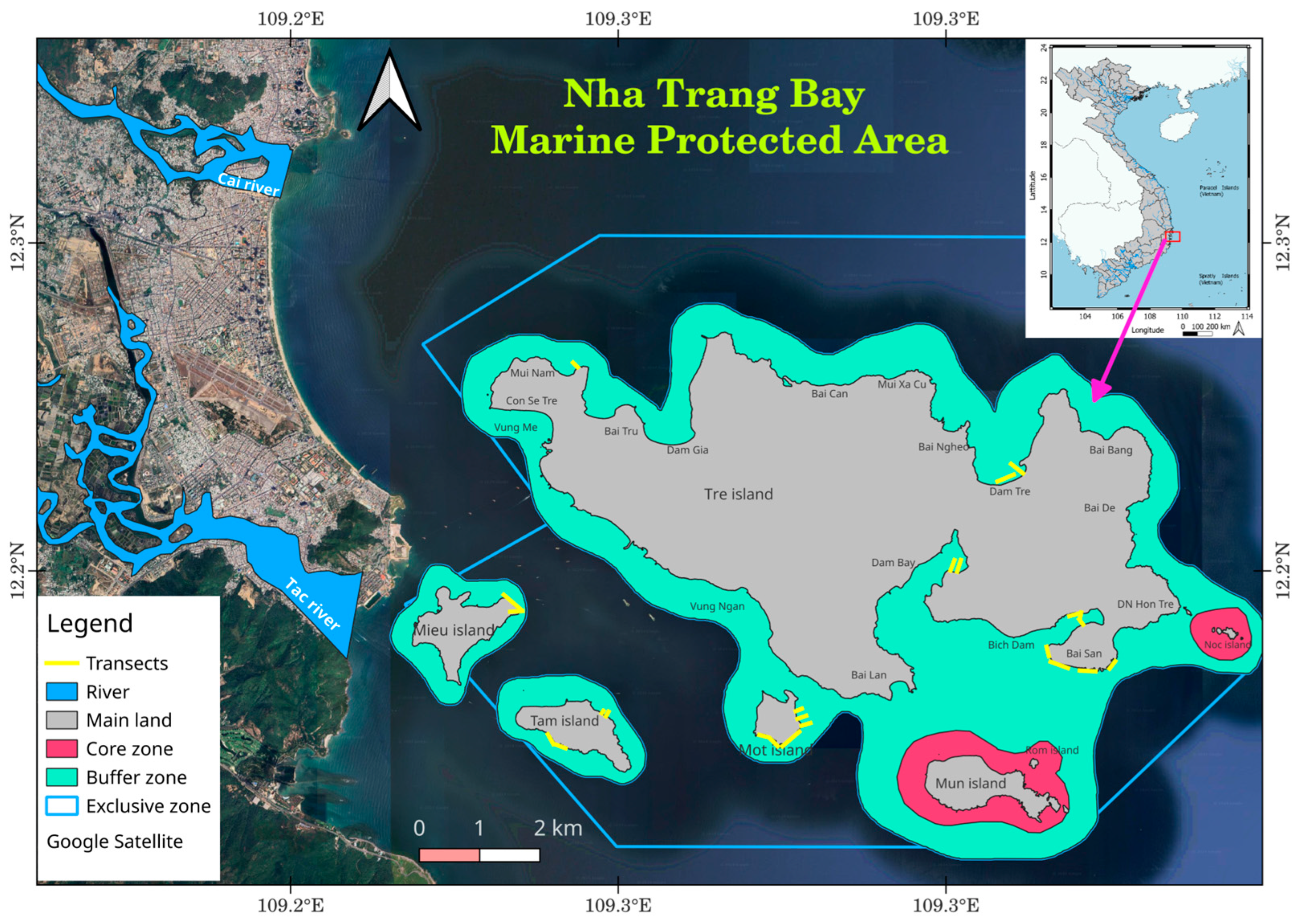
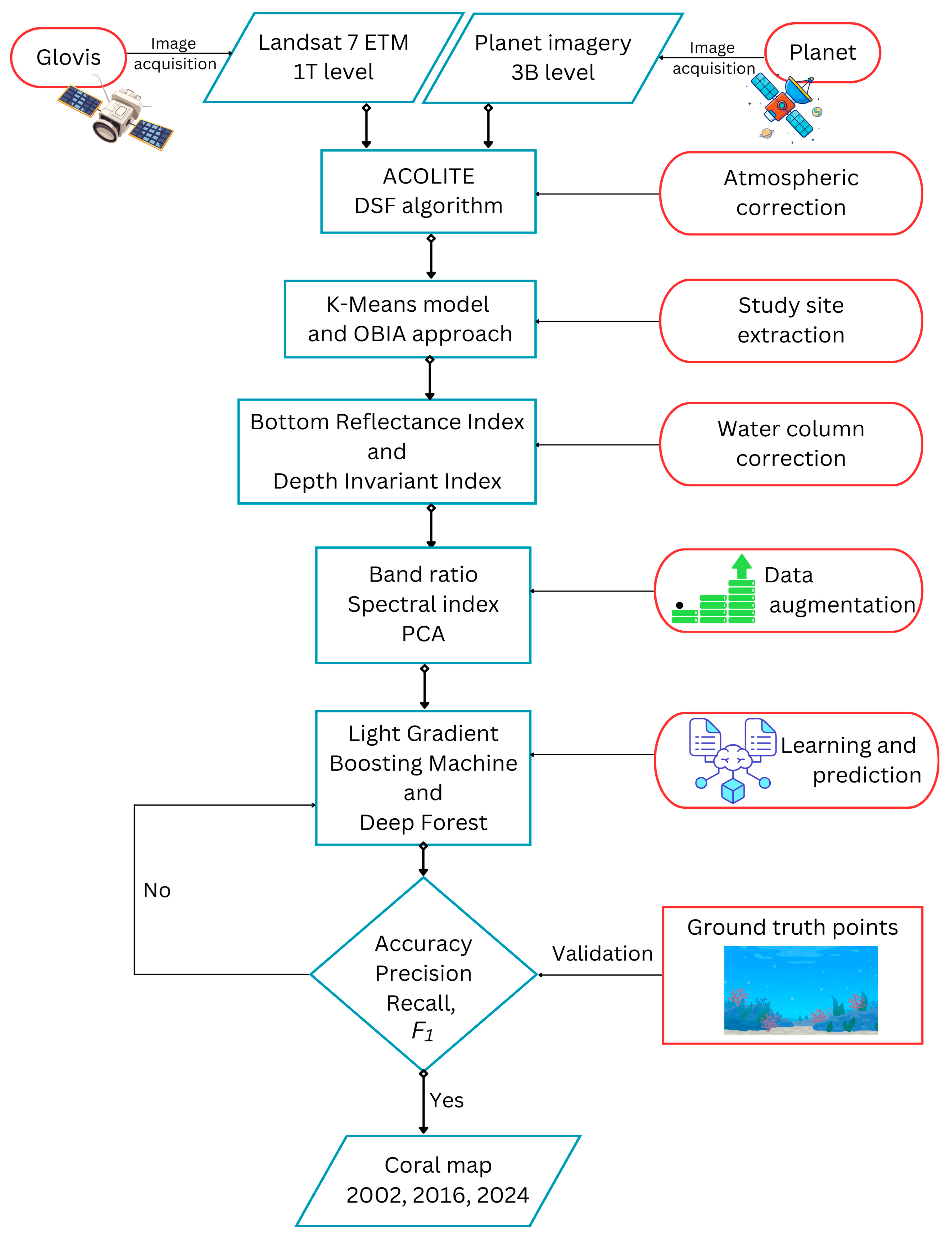
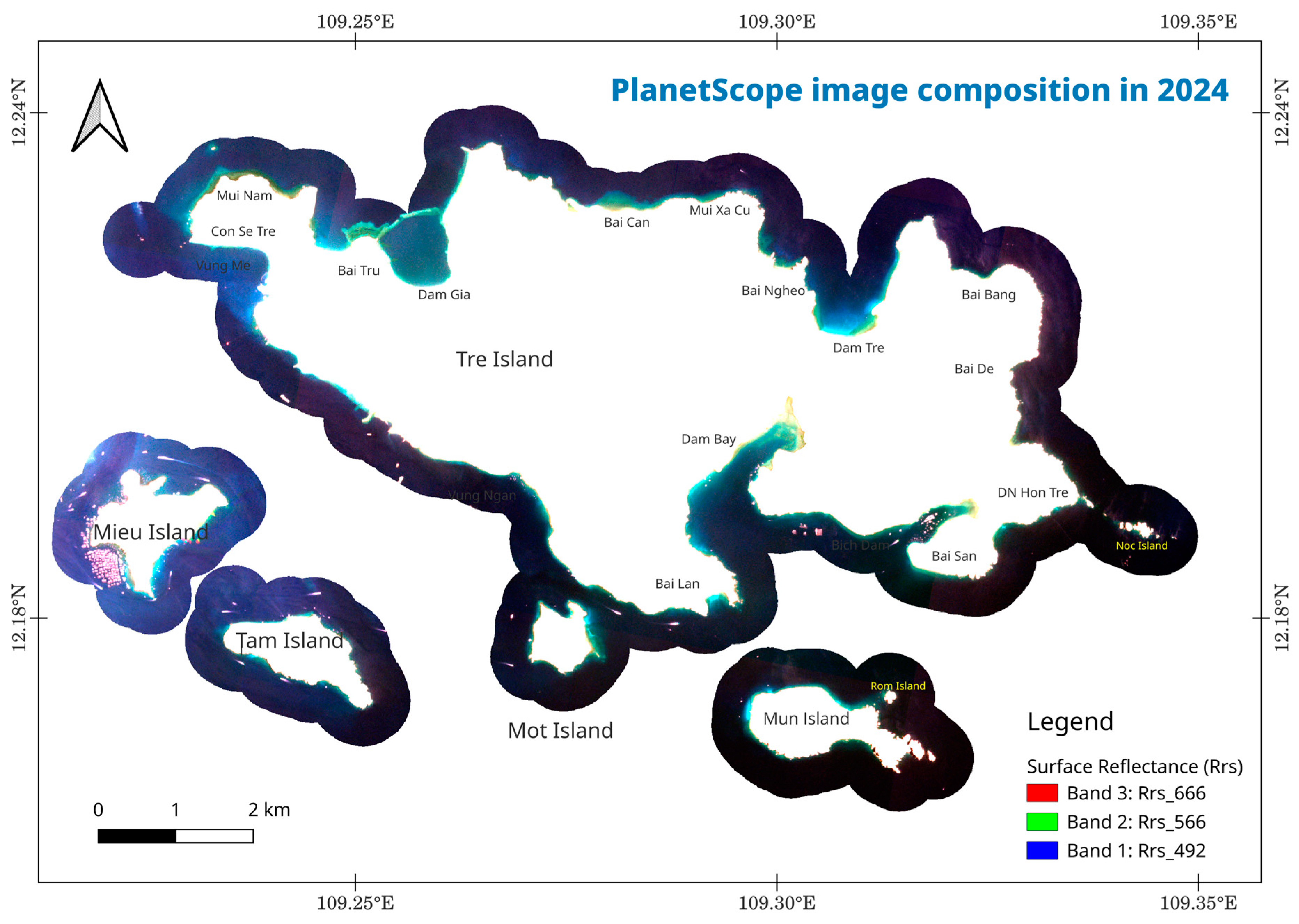

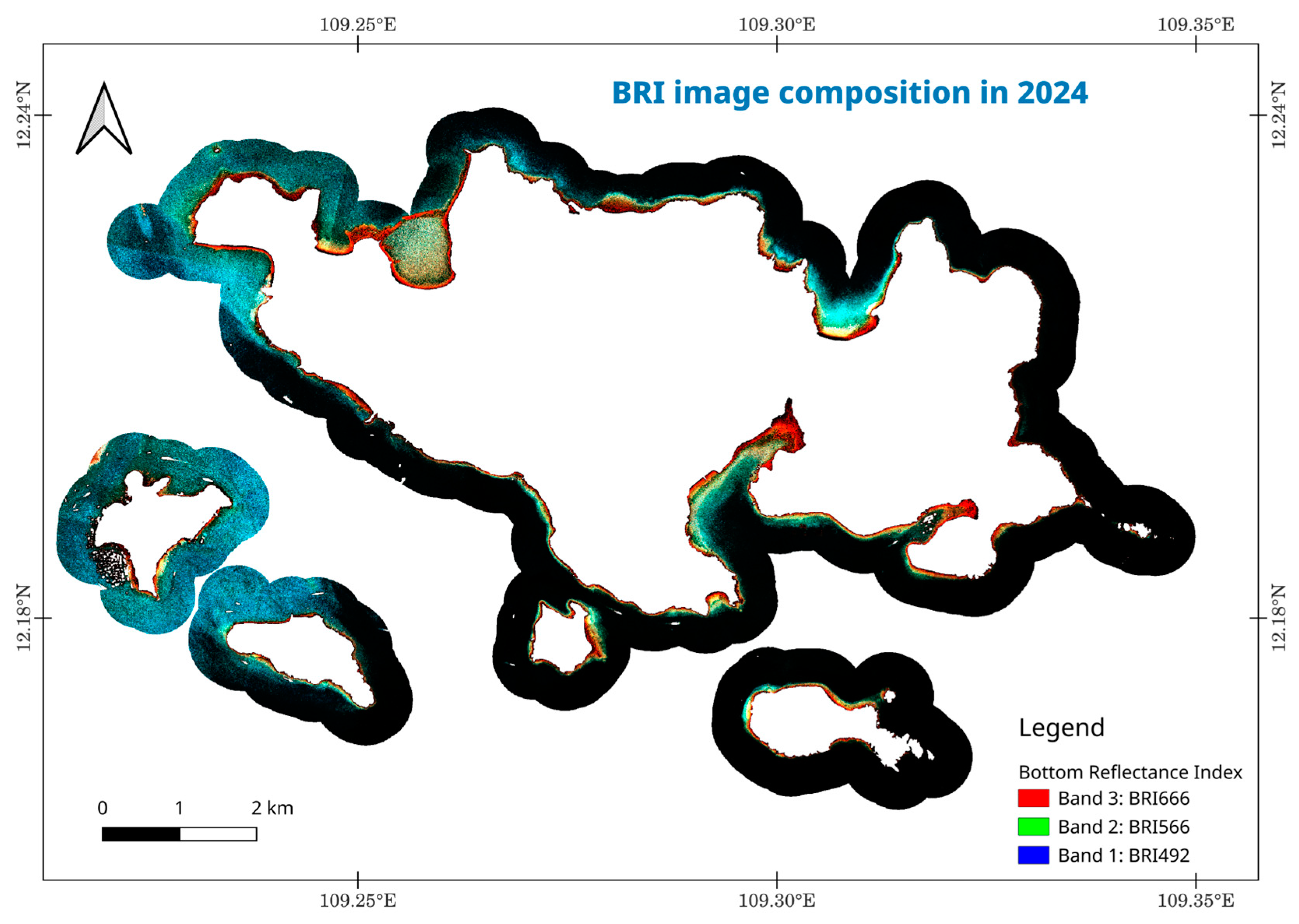

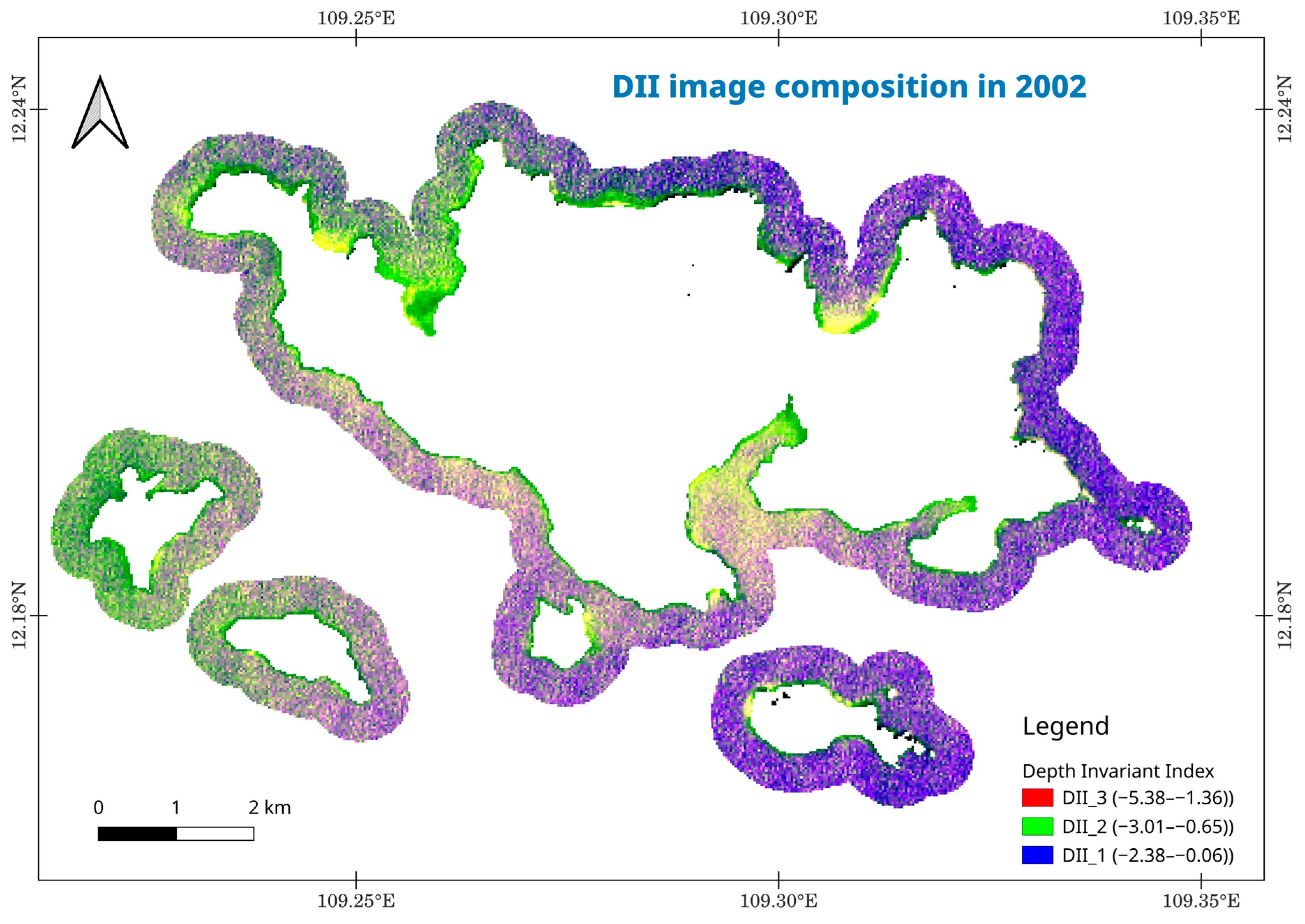



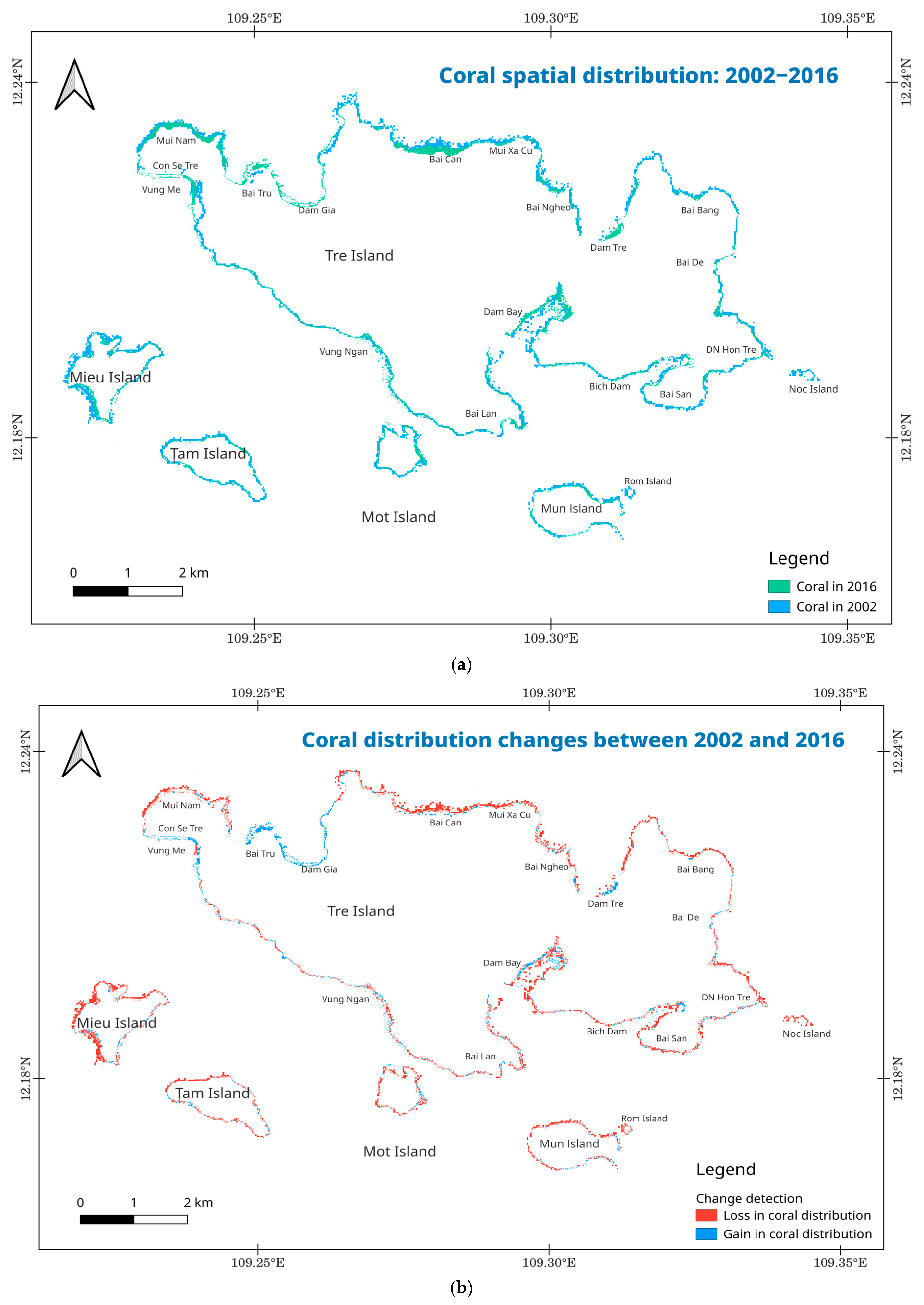



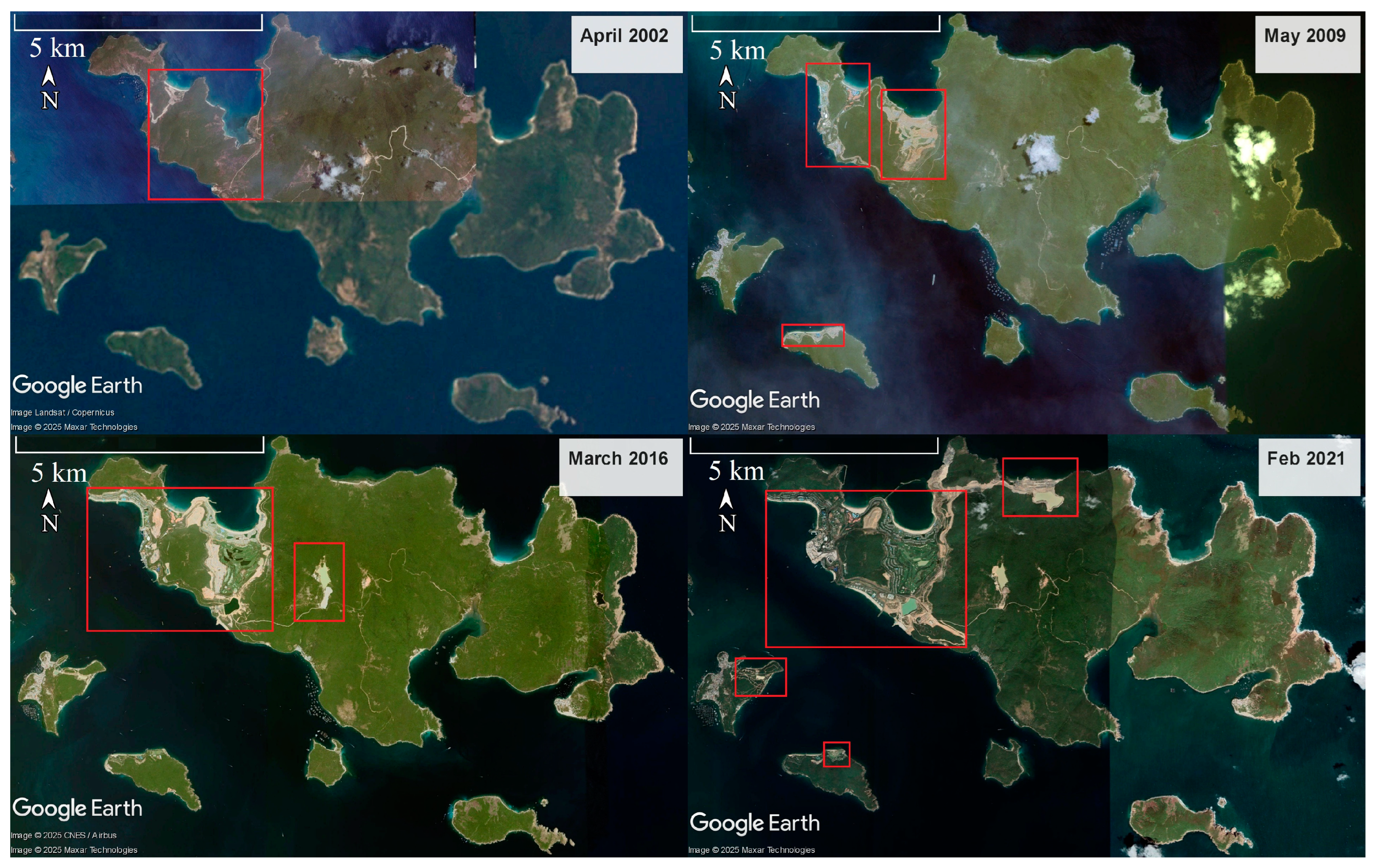


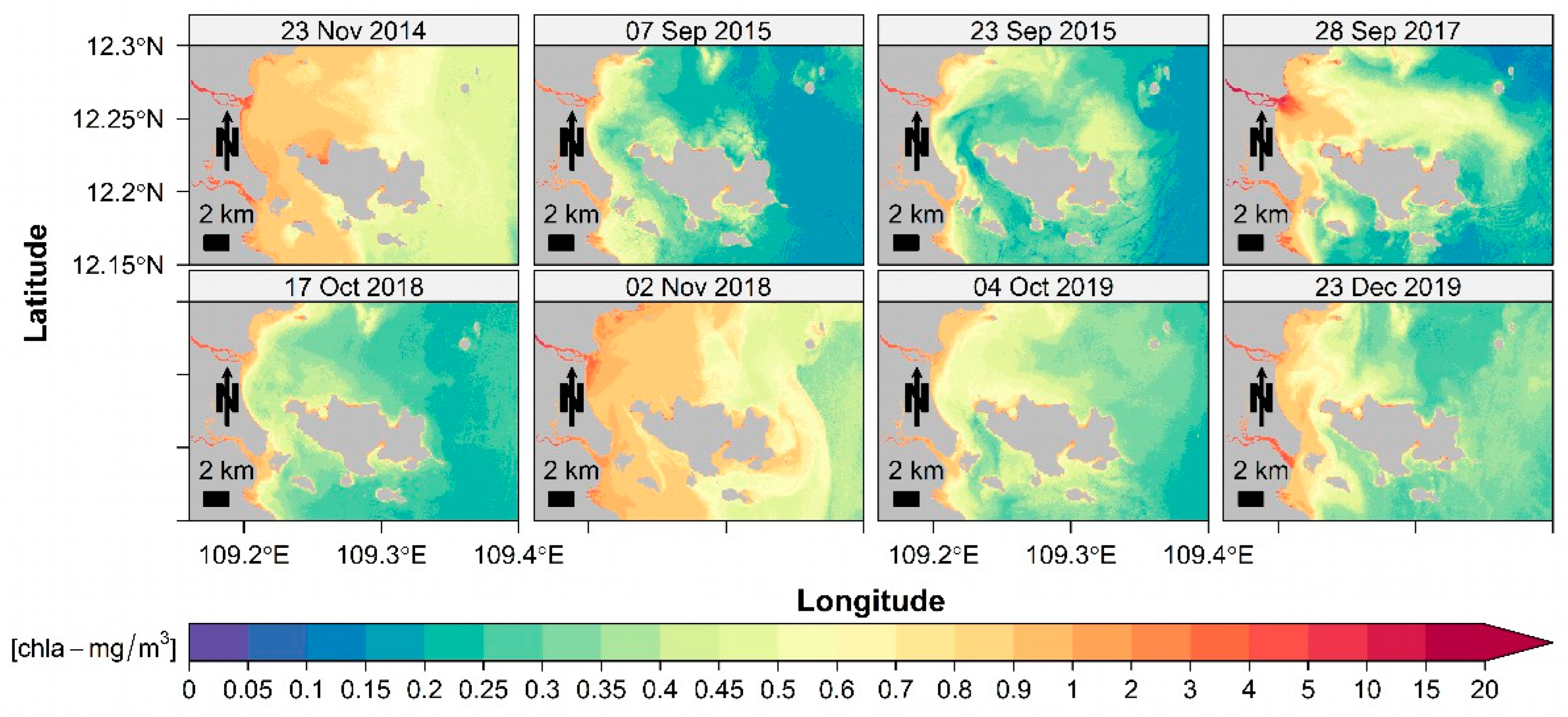
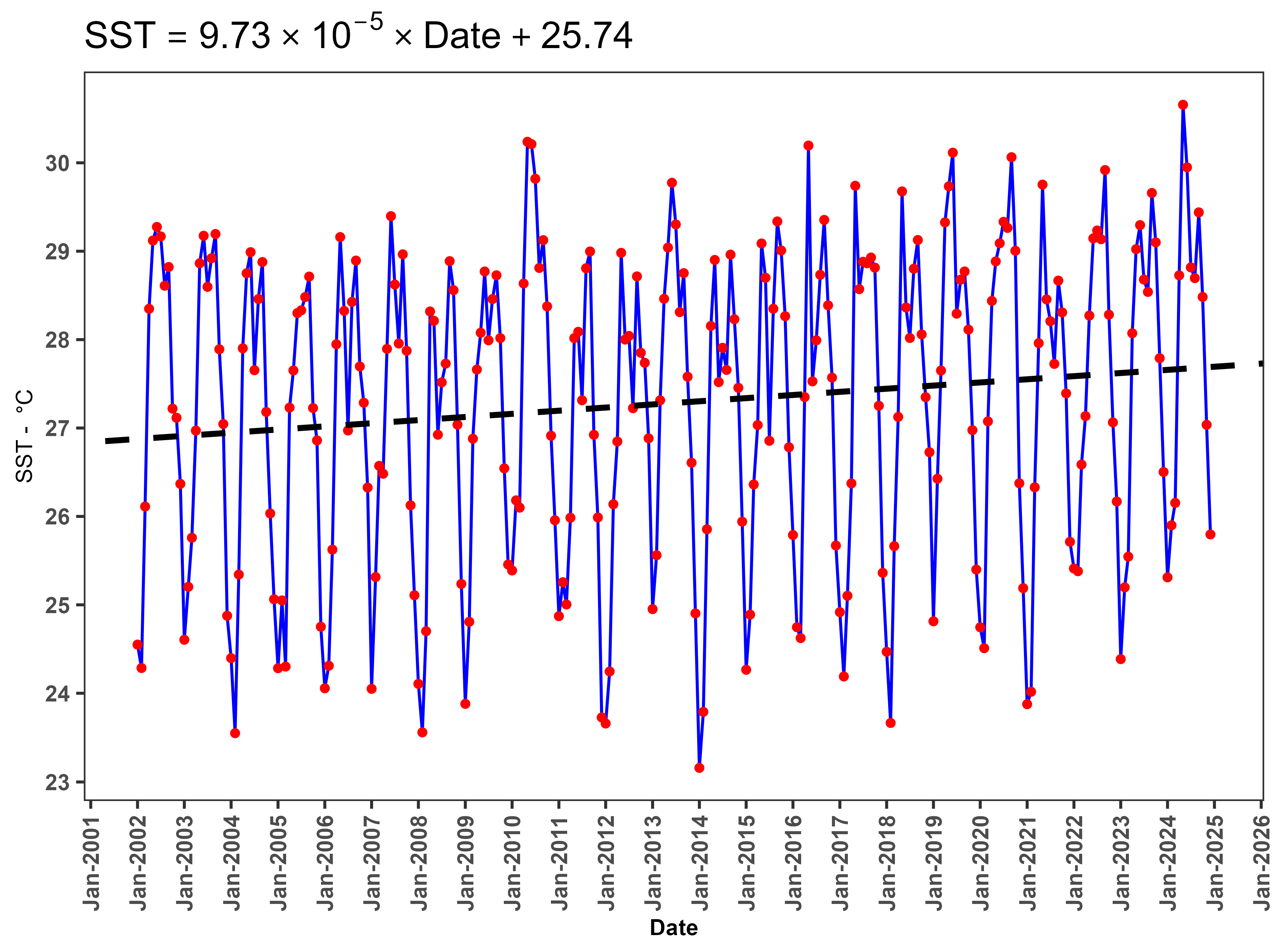
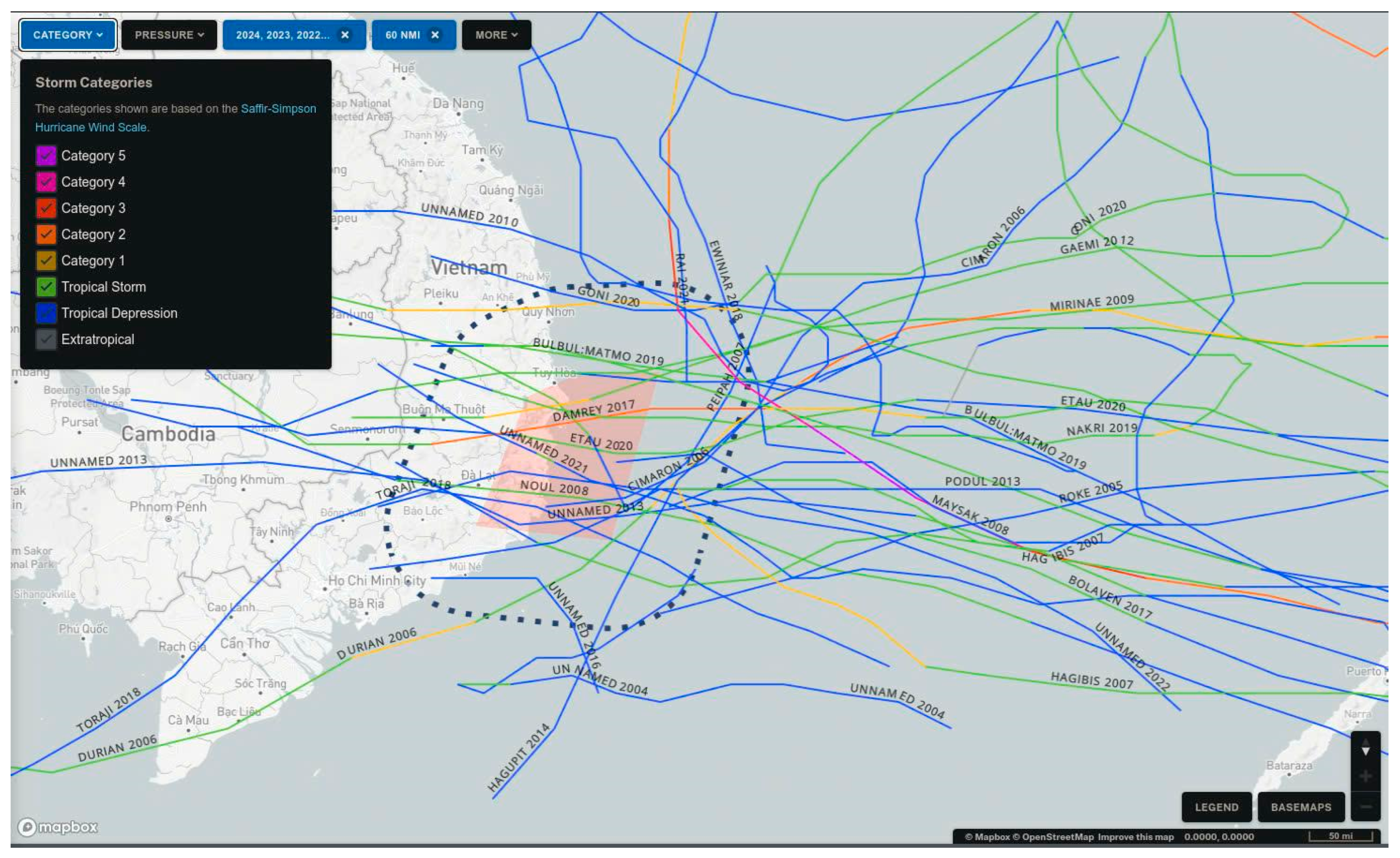
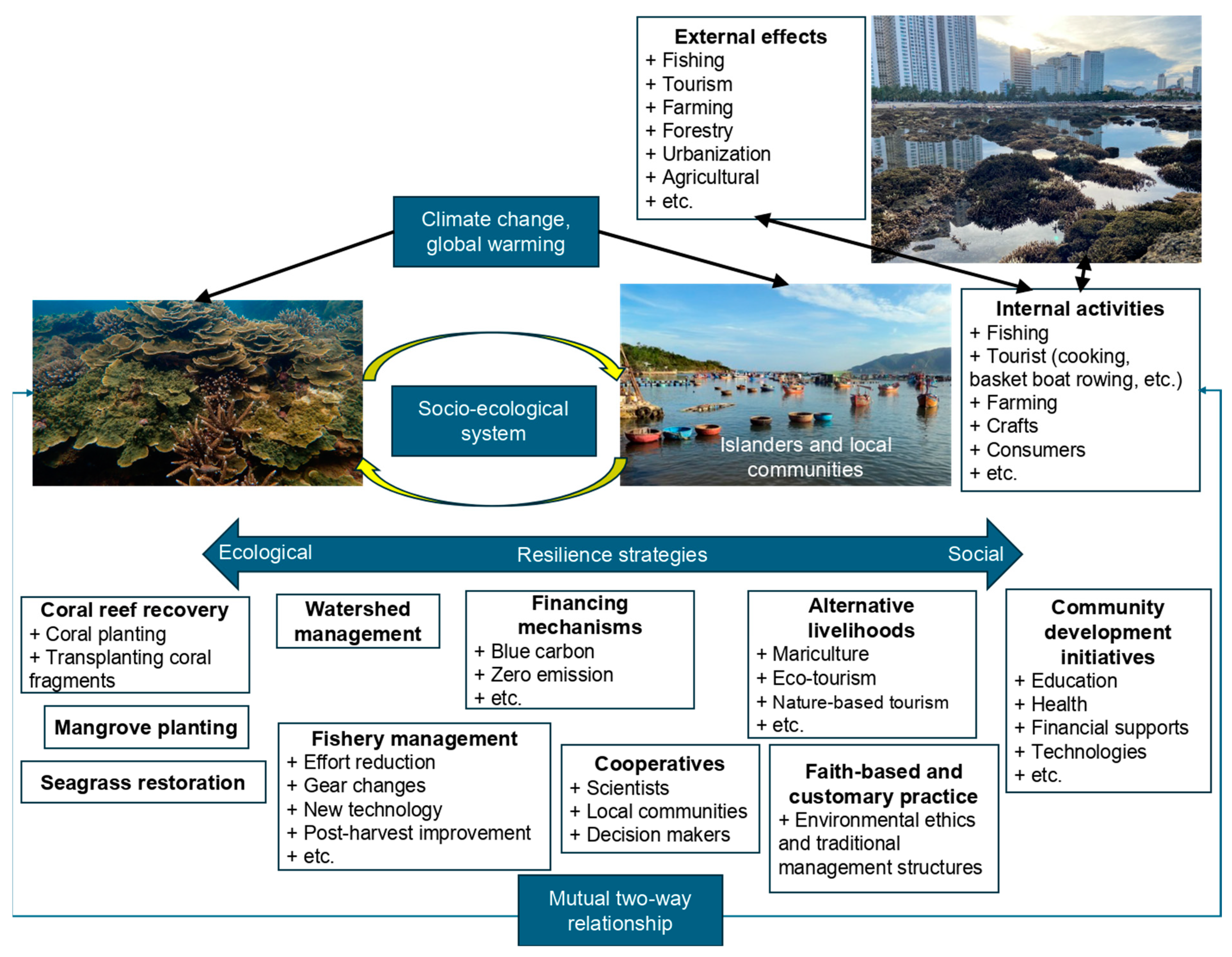
| Scene ID | Date of Acquisition | Processing Level | Cloud Coverage | Spectral Bands | |
|---|---|---|---|---|---|
| Year 2016 | 20160831_022110_0e30 | 31 August 2016 | 3B | 0 | 4 (Blue, Green, Red, NIR) |
| 20160831_022111_0e30 | |||||
| 20160831_022119_0e0e | |||||
| 20160831_022120_0e0e | |||||
| Year 2024 | 20240424_022649_77_24d0 | 24 April 2024 | 3B | 0 | 8 (Coastal, Blue, Green 1, Green 2, Yellow, Red, RedEdge, NIR) |
| Scene ID | Date of Acquisition | Processing Level | Cloud Coverage | Spectral Bands | |
|---|---|---|---|---|---|
| Year 2002 | LE07_L1TP_123052_20020114_20200917_02_T1 | 14 January 2002 | 1T | 7 | 6 (Blue, Green, Red, NIR, SWIR 1, SWIR 2) |
| Parameter | Value |
|---|---|
| aerosol_correction | dark_spectrum |
| dsf_interface_reflectance | True |
| min_tgas_aot | 0.85 |
| min_tgas_rho | 0.70 |
| dsf_residual_glint_correction | False |
| dsf_aot_compute | min |
| dsf_aot_estimate | fixed |
| Output | Surface reflectance at blue, green, and red channels |
| R2 | ||||
|---|---|---|---|---|
| – | 0.93 | 0.94 | ||
| – | 0.87 | 0.80 | ||
| – | 0.73 | 1.00 |
| R2 | ||||
|---|---|---|---|---|
| – | 0.90 | 0.84 | ||
| – | 0.94 | 0.46 | ||
| – | 0.76 | 0.36 |
| Band Ratio | Principal Component Analysis (PCA) | Spectral Index | |
|---|---|---|---|
| Landsat 7 ETM (2002) | Yes | Yes | No |
| Planet (2016) | Yes | Yes | No |
| Planet (2024) | Yes | Yes | Yes |
| Index | Abbreviation | Formula | Reference | |
|---|---|---|---|---|
| 1 | Red–green Ratio index | IRG | r/g | [33] |
| 2 | Excess green index | ExG | 2grb | [34] |
| LGBM | |||
| boosting_type | dart | n_estimators | 90 |
| learning_rate | 0.19 | num_leave | 10 |
| max_depth | −1 | ||
| DF | |||
| max_layers | 20 | n_estimators | 6 |
| use_predictor | True | predictor | lightgbm |
| back_end | sklearn | Predictor_kwargs (lightgbm) | |
| max_depth | −1 | ||
| min_sample_split | 4 | ||
| min_sample_leaf | 4 | ||
| n_estimators | 100 | ||
| learining_rate | 0.09 | ||
| Number of Input Bands | Number of Training Pixels | Number of Validation Pixels | |
|---|---|---|---|
| Landsat 7 ETM (2002) | 10 | 341 | 341 |
| Planet (2016) | 10 | 15,918 | 15,918 |
| Planet (2024) | 12 | 7850 | 7850 |
| Planet (2024) | 0.94 | 0.92 | 0.88 | 0.84 | 0.86 |
| Planet (2016) | 0.92 | 0.89 | 0.82 | 0.83 | 0.82 |
| Landsat 7 ETM+ (2002) | 0.88 | 0.83 | 0.84 | 0.85 | 0.85 |
Disclaimer/Publisher’s Note: The statements, opinions and data contained in all publications are solely those of the individual author(s) and contributor(s) and not of MDPI and/or the editor(s). MDPI and/or the editor(s) disclaim responsibility for any injury to people or property resulting from any ideas, methods, instructions or products referred to in the content. |
© 2025 by the authors. Licensee MDPI, Basel, Switzerland. This article is an open access article distributed under the terms and conditions of the Creative Commons Attribution (CC BY) license (https://creativecommons.org/licenses/by/4.0/).
Share and Cite
Hieu, N.T.D.; Quang, N.H.; Dien, T.D.; Ha, V.T.; Tran, N.D.H.; Son, T.P.H.; Nguyen-Quang, T.; Hang, T.T.T.; Thang, H.N. Trends in Coral Reef Habitats over Two Decades: Lessons Learned from Nha Trang Bay Marine Protected Area, Vietnam. Water 2025, 17, 1224. https://doi.org/10.3390/w17081224
Hieu NTD, Quang NH, Dien TD, Ha VT, Tran NDH, Son TPH, Nguyen-Quang T, Hang TTT, Thang HN. Trends in Coral Reef Habitats over Two Decades: Lessons Learned from Nha Trang Bay Marine Protected Area, Vietnam. Water. 2025; 17(8):1224. https://doi.org/10.3390/w17081224
Chicago/Turabian StyleHieu, Nguyen Trinh Duc, Nguyen Hao Quang, Tran Duc Dien, Vo Thi Ha, Nguyen Dang Huyen Tran, Tong Phuoc Hoang Son, Tri Nguyen-Quang, Tran Thi Thuy Hang, and Ha Nam Thang. 2025. "Trends in Coral Reef Habitats over Two Decades: Lessons Learned from Nha Trang Bay Marine Protected Area, Vietnam" Water 17, no. 8: 1224. https://doi.org/10.3390/w17081224
APA StyleHieu, N. T. D., Quang, N. H., Dien, T. D., Ha, V. T., Tran, N. D. H., Son, T. P. H., Nguyen-Quang, T., Hang, T. T. T., & Thang, H. N. (2025). Trends in Coral Reef Habitats over Two Decades: Lessons Learned from Nha Trang Bay Marine Protected Area, Vietnam. Water, 17(8), 1224. https://doi.org/10.3390/w17081224








